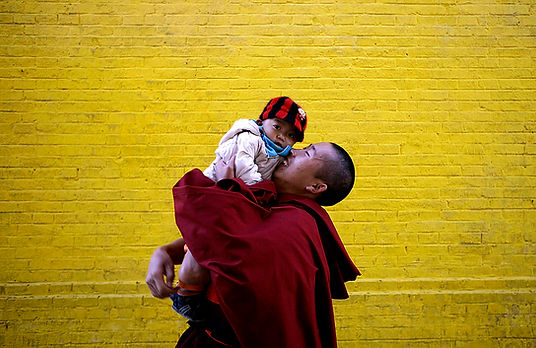
Unexplored Amdo / 5 days
Daily schedule
1 Transfer from Lanzhou to Xiahe. Overnight in Xiahe
2 Visit the Labrang monastery. Overnight in Xiahe
3 Visit the Sangke grasslands. Overnight in Xiahe
4 Continue to Tongren via Ganjia grasslands. Visit Longwu lamasery. See thankha artists at work. Overnight in Tongren
5 Continue to Kumbum, visit the great Kumbum (Ta'er Si) monastery. Late afternoon transfer to Xining
Itinerary:
Day 1: Arrival at Lanzhou airport or train station and transfer to Xiahe. This takes about 5 hours. Around Lanzhou, we can see many houses made of earth and the mountains are dry and brown. After three hours driving, we come into the beautiful green mountains of Xiahe.
Day 2: Today you will visit the Labrang Monastery. This is the largest Tibetan monastery outside of Tibet province. It houses more than 2000 monks from the Yellow Hat tradition and there are 6 schools of Buddhist teachings. In the morning you will join in with the monastery tour. A monk from the monastery guides this tour in English. In the afternoon, our guide will take you to see the printing temple where the sutras are still printed by using wooden blocks. You will also climb up the Golden Stupa for a bird's eye view of the whole complex and you can walk part of the kora which is the prayer wheel route.
Day 3: Today you will explore the grasslands around Xiahe where nomad families live in tents. When invited in their homes you simply can't refuse the infamous Tibetan yak milk tea and barley "tsampa". The grasslands are also a beautiful area for hiking. In summertime the flowers are like a carpet on the meadows.
Day 4: We leave Xiahe and head for Tongren, in Tibetan called Regong. We journey through the Ganjia grasslands, which are more rocky than the Sangke grasslands we have seen yesterday. We can see many small Tibetan settlements on the way. After arrival in Tongren we visit the Longwu lamasery. This colorful yellow sect monastery was built in 1301 and has 4 monastery schools. It is an important cultural and religious temple and it is interesting to visit the many big and many halls. The buildings are built in Tibetan and han Chinese style. In the middle of the temple complex is the Grand Hall, which hosts, among others, 10 Sakyamuni Buddha's.
After the monastery visit, we go to upper and lower Sengeshong monasteries, where we can see about 50 famous thankha artists making the beautiful Buddhist motives on cloth. The Regong arts is very famous.
Day 5: We head for the Ta'er Si temple, which is called Kumbum in Tibetan. It is one of the 6 main yellow sect temples, the Labrang monastery in Xiahe also being one. Kumbum was built in 1560 and since this is the birth place of Tsongkhapa, the founder of yellow sect Buddhism, it has become a very holy place. Many pilgrims come from all over China, Tibet and Mongolia to pray here. Among the most famous halls are: the Great hall (birth place of Tsongkhapa), the hall of Butter Sculptures, the great Meditation hall and the 13 meter high Stupa. Late afternoon transfer to Xining, the capital city of Qinghai province.
